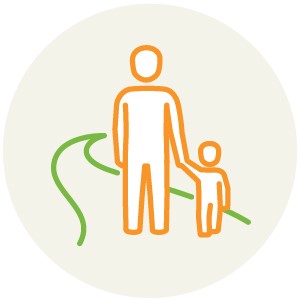Why walking matters
On this page
Benefits of walking
Benefits include:
- promoting health and wellbeing
- reducing congestion and providing increased transport capacity, resilience and savings
- providing an alternative transport option that is accessible to everybody
- increasing economic growth and vitality, and saving money for individuals
- creating opportunities for tourism experiences
- reducing greenhouse gas emissions, air, noise and water pollution
- increasing social connections and enhancing community safety.
- Queensland Walking Strategy 2019-2029, Benefits of walking, page 5 (Department of Transport and Main Roads, 2019)
TMR endorsed guidance
Other useful resources
- Australian Transport Assessment and Planning Guidelines M4 Active Travel (Commonwealth Department of Infrastructure and Regional Development, 2016)
- Queensland Chief Health Officer reports (Queensland Health, 2020)
- The Benefits of Walking: A Research Summary (PDF, 583KB) (Victorian Health Promotion Foundation, 2019)
- The Economic Case for Investment in Walking (Badawi, et al., 2018)
- Benefits of Walking (Heart Foundation, 2020)
- Benefits of Walking (Victoria Walks, 2020)
- Costs of Transport and Physical Inactivity (CWANZ, 2022)
- Economic Benefits of Walking and Cycling (CWANZ, 2022)
- Health Benefits of Active Transport (CWANZ, 2022)
- More People Walking – Keys to Success (CWANZ, 2022)
Who walks and why?
Different age groups have different reasons for walking:
- toddlers
- children
- teenagers/students
- young adults
- adults
- older people.
There are also differences between genders.
TMR endorsed guidance
- Walking: What Queenslanders Told Us, Section 2.1 Why do Queenslanders walk? (Department of Transport and Main Roads, 2020)
Other useful resources
- Young People and Walking in Victoria Research Report (Garrard, 2017)
- Senior Victorians and Walking: Obstacles and Opportunities Research Report (Garrard, 2013)
Types of walking
There are two main reasons for walking:
- transport (e.g. to get to work, school or the shops or to access public transport)
- recreation and relaxation (e.g. walking a dog, walking for exercise or window shopping).
TMR endorsed guidance
- Walking in Queensland Report 2019, Objective 1: More walking, more often (Department of Transport and Main Roads, 2019)
- Walking: What Queenslanders Told Us, Section 2.1 Why do Queenslanders Walk? (Department of Transport and Main Roads, 2020)
Barriers to walking
Barriers include:
- physical barriers e.g. distance to destination, and lack of smooth paths, shade or seating
- vehicle traffic speed and volume, and infrastructure that is unsafe to cross or adequately separated from traffic
- personal barriers e.g. unsuitable climate, not enough time, physical/mental conditions or don’t feel safe.
TMR endorsed guidance
- Walking: What Queenslanders Told Us, Section 2.3 Barriers to Walking and Section 3.2 Challenges and barriers (Department of Transport and Main Roads, 2020)
- Walking in Queensland Report 2019, Personal barriers to walking, page 13 (Department of Transport and Main Roads, 2019)
Other useful resources
- Senior Victorians and Walking: Obstacles and Opportunities (Garrard, 2013)
- Safety Factsheet (CWANZ, 2022)
Opportunities to increase walking
Opportunities include:
- improving infrastructure for walking
- improving amenity of walking environments
- increasing safety for people walking
- using policy and planning to require connected and comfortable walking environments
- providing education and encouragement for people to walk more.
TMR endorsed guidance
- Walking: What Queenslanders Told Us, Section 2.3 Barriers to Walking and Section 2.2 Opportunities to increase walking and Table 1: Opportunities and barriers and for walking by key themes (Department of Transport and Main Roads, 2020)
Physical activity and mental health
Walking should be an easy and accessible way for Queenslanders to help achieve the recommended amount of physical activity required to reduce their risk of chronic disease and obesity.
Walking connects us socially, makes us happier and improves mental wellbeing. Physically active people report being happier and less anxious. They have a stronger sense of social integration.
TMR endorsed guidance
- Queensland Walking Strategy 2019-2029, Benefits of walking, page 5 (Department of Transport and Main Roads, 2019)
Other useful resources
- Australia's Physical Activity and Sedentary Behaviour Guidelines and the Australian 24-Hour Movement Guidelines (Department of Health, 2020)
- Queensland Chief Health Officer reports (Queensland Health, 2020)
- Exercise and Mental Health (Healthdirect, 2020)
- Interactive Australian Heart Maps (Heart Foundation, 2020)
- Is Walking a Miracle Cure? (Living Streets, 2020)
- Walking and Mental Health (The MindShift Foundation, 2021)
- Last updated 31 March 2023

